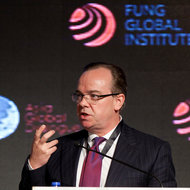Time Warner, the parent company of HBO, CNN, TNT and TBS, on Wednesday reported revenue of $6.9 billion in the quarter that ended March 31, down 1 percent from the same period last year. Net income grew 23.5 percent, to $720 million, or 75 cents a share, compared with $583 million, or 59 cents a share, in 2012.
Revenue at the company’s Warner Brothers studio fell 4 percent to $2.7 billion, while operating income increased by 23 percent to $263 million. “Both ‘Gangster Squad’ and ‘Jack the Giant Slayer’ fell below our expectations,” Jeffrey L. Bewkes, Time Warner’s chairman and chief executive, told analysts.
He remained optimistic however about the studio’s coming films, including “The Great Gatsby” and “The Hangover Part III.” Warner Brothers had a strong television season with “Revolution,” an apocalyptic drama on NBC, and “Game of Thrones,” the HBO fantasy series that averages 13.4 million viewers per episode.
Viacom felt the impact of a disappointing quarter at Paramount Pictures, which contributed to an 18 percent decline in earnings at the company, to $478 million, or 96 cents a share, versus $1.07 a share in the same three-month period last year. Overall revenue at Viacom fell 6 percent to $3.14 billion mostly because of the film division.
Revenue at Paramount dropped 20 percent to $941 million, a year ago, in part because of the company’s strategy to release only a handful of franchise films each year. Philippe P. Dauman, Viacom’s president and chief executive, said “the year ahead remains strong with audiences eagerly awaiting” releases like “World War Z” and “Star Trek Into Darkness.”
Both companies posted strong quarters in cable television. Mr. Bewkes specifically pointed to the success of Time Warner’s cable division, which benefited this quarter from the average nightly audience of 10.7 million for the N.C.A.A. basketball tournament broadcast on several Turner channels.
Viacom posted a 2 percent drop in operating income at its media networks, which include Nickelodeon, Comedy Central and MTV. Advertising revenue growth of 2 percent and improved ratings at Nickelodeon and Nick Jr. helped Viacom slightly surpass analysts’ expectations. “Nickelodeon rebounded with preschool audiences,” Mr. Dauman said. Combined revenue at the cable channels rose 2 percent to $2.23 billion.
Like Nickelodeon, Time Warner’s CNN cable network has also experienced ratings softness recently. Mr. Bewkes defended CNN under the leadership of Jeff Zucker, the recently named president of CNN Worldwide. But, he said, the channel still needed to evolve from a trusted source of breaking news to a more regularly watched outlet. “CNN can’t just be politics and wars,” Mr. Bewkes said.
Both companies are grappling with a changed television landscape. Online streaming services offered by Netflix, Amazon and Hulu are providing additional avenues of syndication revenue but also, in some cases, competition. Nickelodeon’s revenues had dipped last year in part because children were turning to Netflix to watch a deluge of episodes of “SpongeBob SquarePants.”
Mr. Dauman said Viacom was in “constructive discussions with several parties, including Netflix, concerning digital distribution” agreements beyond an agreement with Netflix that will expire later this month.
Mr. Bewkes rebuffed questions about whether the HBO Go on-demand app would be made available on an à la carte basis through a broadband connection, making the premium cable channel more like the streaming service Netflix. “We would do it if we thought it was in our economic best interest,” Mr. Bewkes said. “At this point, we don’t think it makes sense.”
This article has been revised to reflect the following correction:
Correction: May 1, 2013
A headline with an earlier version of this article misstated Time Warner’s results. It reported lower revenue, not lower earnings.
Article source: http://www.nytimes.com/2013/05/02/business/media/viacom-and-time-warner-post-lower-earnings.html?partner=rss&emc=rss

